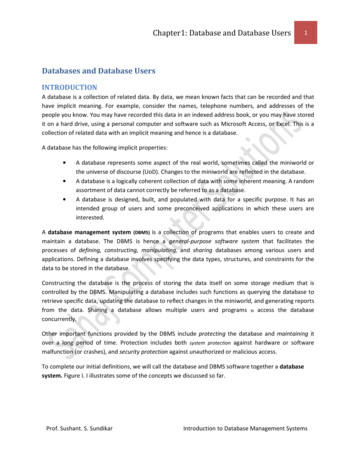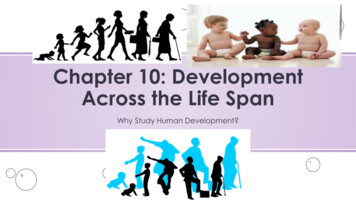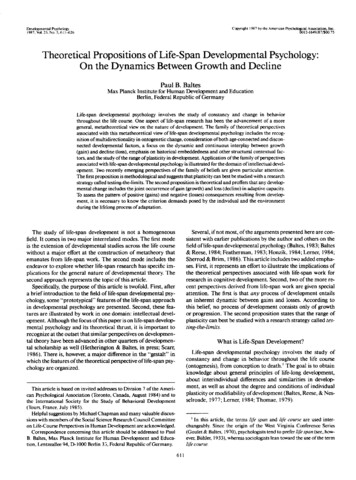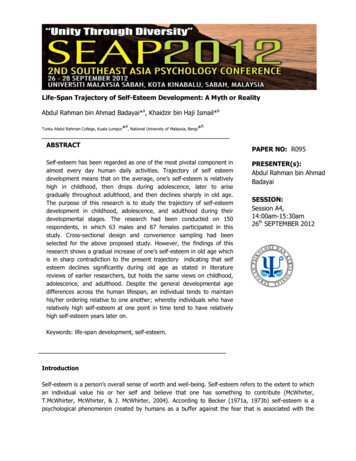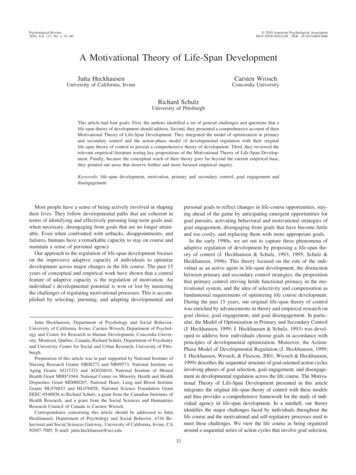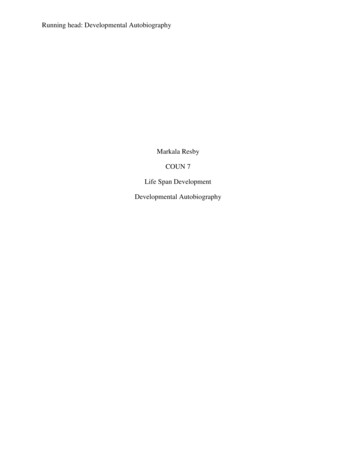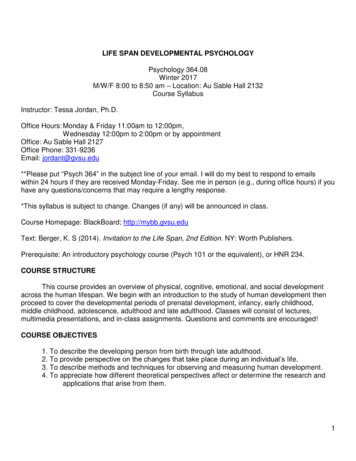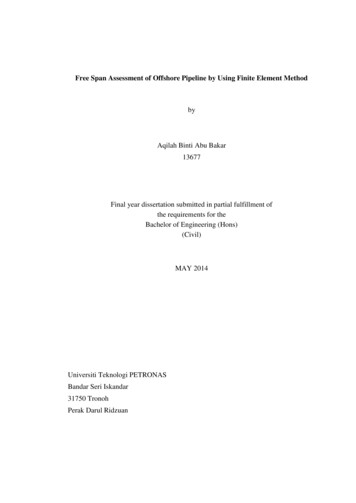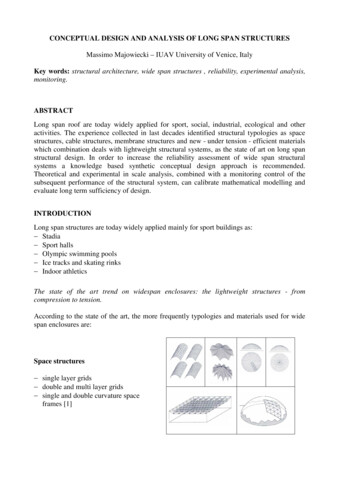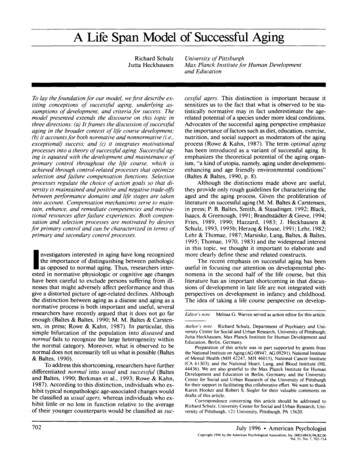
Transcription
A Life Span Model of Successful AgingRichard SchulzJuRa HeckhausenTo lay the foundation for our model, we first describe existing conceptions of successful aging, underlying assumptions of development, and criteria for success. Themodel presented extends the discourse on this topic inthree directions: (a) It frames the discussion of successfulaging in the broader context of life course development;(b) it accounts for both normative and nonnormative (i.e.,exceptional) success; and (c) it integrates motivationalprocesses into a theory of successful aging. Successful aging is equated with the development and maintenance ofprimary control throughout the life course, which isachieved through control-related processes that optimizeselection and failure compensation functions. Selectionprocesses regulate the choice of action goals so that diversity is maintained and positive and negative trade-offsbetween performance domains and life stages are takeninto account. Compensation mechanisms serve to maintain, enhance, and remediate competencies and motivational resources after failure experiences. Both compensation and selection processes are motivated by desiresfor primary control and can be characterized in terms ofprimary and secondary control processes.Investigators interested in aging have long recognizedthe importance of distinguishing between pathologicas opposed to normal aging. Thus, researchers interested in normative physiologic or cognitive age changeshave been careful to exclude persons suffering from illnesses that might adversely affect performance and thusgive a distorted picture of age-related declines. Althoughthe distinction between aging as a disease and aging as anormative process is both important and useful, severalresearchers have recently argued that it does not go farenough (Baltes & Baltes, 1990; M. M. Baltes & Carstensen, in press; Rowe & Kahn, 1987). In particular, thissimple bifurcation of the population into diseased andnormal fails to recognize the large heterogeneity withinthe normal category. Moreover, what is observed to benormal does not necessarily tell us what is possible (Baltes& Baltes, 1990).To address this shortcoming, researchers have furtherdifferentiated normal into usual and successful (Baltesand Baltes, 1990; Berkman et al., 1993; Rowe & Kahn,1987). According to this distinction, individuals who exhibit typical nonpathologic age-associated changes wouldbe classified as usual agers, whereas individuals who exhibit little or no loss in function relative to the averageof their younger counterparts would be classified as suc702University of PittsburghMax Planck Institute for Human Developmentand Educationcessful agers. This distinction is important because itsensitizes us to the fact that what is observed to be statistically normative may in fact underestimate the agerelated potential of a species under more ideal conditions.Advocates of the successful aging perspective emphasizethe importance of factors such as diet, education, exercise,nutrition, and social support as moderators of the agingprocess (Rowe & Kahn, 1987). The term optimal aginghas been introduced as a variant of successful aging. Itemphasizes the theoretical potential of the aging organism, "a kind of utopia, namely, aging under developmentenhancing and age friendly environmental conditions"(Baltes & Baltes, 1990, p. 8).Although the distinctions made above are useful,they provide only rough guidelines for characterizing theaged and the aging process. Given the proliferation ofliterature on successful aging (M. M. Baltes & Carstensen,in press; P. B. Baltes, Smith, & Staudinger, 1992; Black,Isaacs, & Greenough, 1991 ; Brandtst/idter & Greve, 1994;Fries, 1989, 1990; Hazzard, 1983; J. Heckhausen &Schulz, 1993, 1995b; Herzog & House, 1991 ; Lehr, 1982;Lehr & Thomae, 1987; Marsiske, Lang, Baltes, & Baltes,1995; Thomae, 1970, 1983) and the widespread interestin this topic, we thought it important to elaborate andmore clearly define these and related constructs.The recent emphasis on successful aging has beenuseful in focusing our attention on developmental phenomena in the second half of the life course, but thisliterature has an important shortcoming in that discussions of development in late life are not integrated withperspectives on development in infancy and childhood.The idea of taking a life course perspective on developE d i t o r note.Melissa G. Warren served as action editor for this article.Richard Schulz, Department of Psychiatry and University Center for Social and Urban Research, University of Pittsburgh;JuRa Heckhausen, Max Planck Institute for H u m a n Development andEducation, Berlin, Germany.Preparation of this article was in part supported by grants fromthe National Institute on Aging (AG 08947, AG 09291), National Instituteof Mental Health (MH 42247, MH 46015), National Cancer Institute(CA 61303), and the National Heart, Lung, and Blood Institute (HL44436). We are also grateful to the Max Planck Institute for H u m a nDevelopment and Education in Berlin, Germany, and the UniversityCenter for Social and Urban Research of the University of Pittsburghfor their support in facilitating this collaborative effort. We want to thankKaren Hooker and Robert S. Siegler for their valuable comments ondrafts of this article.Correspondence concerning this article should be addressed toRichard Schulz, University Center for Social and Urban Research, University of Pittsburgh, 121 University, Pittsburgh, PA 15620.Author's note.July1996 American PsychologistCopyright1996by the AmericanPsychologicalAssociation,Inc. 0003-066X/96/ 2.00Vol. 51. No. 7, 702-714
functioning can be maximized in multiple different domains. Moreover, because there are absolute limits to thea m o u n t of time available to live one's life (Fries, 1983),there are limits on our ability to effectively shift from onedomain to another. At any given point in an individual'slife, the anticipated amount of time left to live may shapebehavior and affect in important ways. A case in point iscareer planning near retirement age. There is a point inthe life course beyond which one has to settle for whatone has, rather than entertain ideas about possible careerchanges (Neugarten & Hagestad, 1976).Biological Development Follows a SequentialPatternRichard Schulzmerit is emphasized by Marsiske et al. (1995) when theydescribed successful development as lifelong adaptation.Successful development is possible throughout the lifespan, and a comprehensive theory of development shouldbe able to explain developmental phenomena from infancy to old age.To present our model of successful aging within alife course perspective, we first examine four basic parameters of life course development. This is followed bya discussion of criteria for successful development, generalprinciples regulating development across the life course,and our own model of developmental regulation. Weconclude by reexamining the concept of successful agingfrom the perspective of our model and exploring some ofthe research implications of this view.Parameters of Life CourseDevelopmentNo one is born old. To be old means that one necessarilyhas a past history and a potential future that provide acontext for characterizing the individual at a given pointin time. This idea can be extended to individuals of allages and emphasizes the importance of viewing life aspart of a continuous and dynamic stream with a beginningand an end. As the contours of land determine the directions of its flow, the life course of individuals is broadlyconstrained by biological and social forces that fundamentally shape the development of the organism. Inasmuch as these constraints affect how we conceptualizeand define aging, it is important that we identify themhere.Life Is FiniteWhatever is to be achieved or experienced in life has tobe done in a finite period of time, typically less than 80years. Because the acquisition of skills, knowledge, andhigh levels of expertise takes time (Ericsson & Charness,1994), the individual is constrained to the extent to whichJuly 1996 American PsychologistAlthough there is considerable interindividual variabilityin biological development, the overall biological resourcesacross the life span resemble an inverted U-function.During childhood and adolescence, cognitive and physicalabilities increase and provide the bases for the development of complex motor and cognitive skills. During earlyadulthood, physical development plateaus and then laterdeclines (Schulz & Curnow, 1988; Schulz, Musa, Staszewski, & Siegler, 1994). In old age, declines in bothphysical and cognitive functioning are evident (Berkmanet al., 1993), although the rate of decline and domains inwhich decline occurs is quite variable and may not beirreversible (Schaie, Willis, & O'Hanlon, 1994). We agreethat there is a great deal of interindividual heterogeneityin h u m a n aging (P. B. Baltes, Smith, & Staudinger, 1992),but there is also consistency and homogeneity, as shownby these broad invariant age-related changes. Thus, it isunlikely that either an 80-year-old or a 10-year-old willever achieve a world record time in the 100-meter dash.Societies Impose Age-Graded SociostructuralConstraints on DevelopmentLife span psychologists and life course sociologists emphasize that all societies can be characterized as havingage-graded systems that constrain and provide a scaffoldfor life course patterns (P. B. Baltes, 1991; Hagestad, 1990;Hagestad & Neugarten, 1985; J. Heckhausen, 1990,1995). These patterns provide predictability and structureat both individual and societal levels. Societies definenormative ages for important life events and transitions,sometimes referred to as developmental tasks (Havighurst,1973). The prototypical case is fertility in women, whichis shaped by both social institutions and biological constraints. In addition, age-sequential constraints resultfrom a channeling of developmental and life course processes into biographical tracks (Blossfeld & Mayer, 1988;Featherman & Lerner, 1985; Geulen, 1981; Mayer, 1986).An example is professional specialization, which yieldsever-increasing levels of expertise in the chosen field whilegiving up on nonchosen alternatives. Within such developmental tracks, functioning is optimized, whereascrossovers to alternative life tracks become increasinglydifficult.703
JuttaHeckhausenGenetic Potential Is a Limiting Factor onFunctional D e v e l o p m e n tAlthough the potential behavioral repertoire of humansis vast, the capacity to achieve extraordinary levels offunctioning in a given domain may be constrained by thegenetic makeup of an individual. For example, becominga professional athlete in sports such as basketball andfootball is improbable for individuals who do not possessthe genetically determined physical attributes requiredby these sports. One of the important challenges for maximizing functioning over the life course is to provideyoung children with adequate opportunities to test outtheir genetic potential so that there is a good match between the genetic makeup of the individual and a selectedlife track. Scarr and McCartney (1983) referred to thisprocess as niche-building and suggested that "childrenselect and build niches that are correlated with their talents, interests, and personality characteristics" (p. 433).The C r i t e r i o n P r o b l e mAs noted by others (M. M. Baltes & Carstensen, in press;Baltes & Baltes, 1990), terms such as successfulor optimalimply a value judgment about something that is goodand desirable. Some advocates of successful aging focuson outcomes such as cardiovascular and pulmonaryfunctioning and the absence of disability as measures ofsuccess (Berkman et al., 1993; Rowe & Kahn, 1987).Others emphasize cognitive and intellectual performanceas measures of success (Lehman, 1953; Salthouse, 1991;Simonton, 1988a, 1988b, 1994), whereas still others focuson achievements in physical (Ericsson, 1990; Ericsson &Charness, 1994; Schulz & Curnow, 1988; Schulz et al.,1994) or artistic domains (Ericsson, Krampe, & TeschRomer, 1993; Lehman, 1953; Simonton, 1988a, 1994).A c o m m o n feature of all of these criteria is that theyfocus on broad measurable domains of functioning orperformance that can be applied to any stage of the lifecourse, and for which there exists broad societal consensus704that the higher the level of functioning or performance,the more successful the individual.A variation of this approach uses the same outcomemeasures but views them through a relativist filter (Schulz& Hanusa, 1980). Thus, we may take into account contextual environmental or biological factors in assessingthe success of an individual. For example, an individualwith polio may be very limited in physical functioningwhen viewed through the lens of absolute or normativestandards, but may be exceptional when other standards(e.g., compared with persons afflicted with polio) are applied. The same type of analysis could be applied to avery old person who is extraordinarily physically active.When compared with peak performance of elite athletes,such an individual might be viewed as dysfunctional, butcompared with others of the same age, the same personcould be assessed as superfunctional. In summary, threedifferent types of standards can be invoked to assess individual performance within a given domain: an absolutestandard, in which the highest levels of known h u m a nperformance in a given domain defines the upper limit;an interindividual relative standard, which is based onmembership in a particular reference group defined byage or other characteristics (i.e., interindividual socialcomparisons); or an intraindividual relative standard, onebased on the specific performance history of a given individual (i.e., intraindividual temporal comparisons;Schulz & Hanusa, 1980; Suls & Mullen, 1982).Another approach to defining successful aging focuses more on the subjective psychological experience ofthe individual. This approach is in part captured by thenotion that it is not so much what you do or accomplishin life but rather how you feel about it. In contrast toperformance-based criteria, this perspective emphasizessatisfaction with experienced outcomes as a primary criterion of success. A variant of this perspective is to definesuccess in terms of goal attainment, subjectively definedas the realization of desired outcomes and the avoidanceof undesired outcomes. The key feature of these criteriais that success is defined in relation to personal goals andaspirations that are thought to vary over time and sociocultural contexts. Thus, individuals who, by some objective standards, accomplish relatively little within a givendomain or who aspire toward and achieve highly idiosyncratic goals can experience high levels of satisfactionand success. Adopting these highly individualized andsubjective criteria as gauges for successful developmentseems to us problematic for several reasons. First, theyopen the door for any indicator to meet the criteria ofsuccess because the criteria are individually determined.Second, they are subject to the rationalization biasescharacteristic of individuals when they evaluate their ownexperiences and accomplishments. Third, this perspectivefails to take advantage of the fact that all cultures arecharacterized by considerable consensus regarding whatconstitutes success.For these reasons, we feel it important to focus oncriteria of success that are externally measurable and include domains of functioning that have been and continueJuly 1996 American Psychologist
to be valued by cultures throughout time. These includephysical functioning; cognitive, intellectual, affective, andcreative functioning; and social relations. We recognizeand acknowledge that trade-offs have to be made in attempting to maximize functioning in individual or multiple domains and that performance can be evaluatedcomparatively, as specified above. In this context, subjective evaluations such as satisfaction with aging can beviewed as one of m a n y components of affective and intellectual functioning, but they are not treated as majorcriteria of successful development in their own right.Finally, it is important to note the difference betweenevaluating performance and functioning at a given pointin an individual's development and evaluating the totalityof an individual's life. There is a tendency among researchers on successful aging to define success in termsof functioning in one or several domains at a specifictemporal point. Such an assessment may not take intoaccount the totality of an individual's life history or allof the relevant domains by which one might be evaluated.In general, it is much easier to determine if people havedone well within a particular domain than it is to determine whether they have lived a successful life. Similarly,we can define optimal functioning as the convergence ofgenetic potential, biological capacity, acquired knowledgeand skills, motivation, and sociostructural opportunitiesto maximize performance in a given domain; however,defining the optimal life course is more complex becausewe must consider functioning in multiple domains overlong periods of time, which involve sequential variationsin biological and sociostructural opportunities andconstraints.General Principles RegulatingDevelopment Across the Life CourseHaving identified some basic parameters of life coursedevelopment as well as criteria for success, we focus nowon general principles for constructing a successful lifecourse.H u m a n beings have a vast potential for what theycan become and accomplish in a lifetime. To some extent,this potential is constrained by the genetic makeup of theindividual. In extreme cases involving congenital illnesses,the constraints may be severe enough to make a typicallife course difficult to achieve. For most individuals, thegenetic potential is not a major constraint and is, in anycase, relatively unknown.Although much of infancy and childhood is characterized by generalized skill acquisition and cognitivedevelopment, one of the initial challenges faced by socializing agents--such as parents--is to provide to children opportunities to sample diverse domains so thatthere is some convergence between the inherent abilitiesof the child and the investment of time and effort. Identifying such a convergence and subsequently investinglarge amounts of training resources in a specific domainis often characteristic of children who ultimately developworld-class expertise in areas such as playing a musicalinstrument or becoming a professional athlete (EricssonJuly 1996 American Psychologistet al., 1993). On the whole, though, social systems aredesigned to maximize the acquisition of broad generalizable skills throughout infancy, childhood, andadolescence.During late adolescence and young adulthood, thereis increasing pressure for specialization as individualsembark on individualized career paths. How much timeand energy one should invest and in what specific domainsare some of the challenges faced by individuals in thisstage of development. Because of biological limits on thelength of life, the age-graded structure of the life course,and the fact that skill acquisition takes a relatively longperiod of time, the individual has few opportunities tomake mistakes in choosing domains for expertise development. To the extent that individuals invest in the development of domains that are highly generalizable (e.g.,traditional academic skills), the number of alternative career paths remains relatively high. On the other hand,investing in highly specialized domains (e.g., athletic performance in a specific sport) is much riskier because failure to achieve professionally competitive levels of performance leaves one with few alternative domains topursue. This is the classic dilemma of high school or college athletes who invest great energy in developing expertise in their chosen sport but who are not good enoughto become professional athletes. In summary, desirablefeatures for early life course development are exposureto diversity followed by selective investment in highlygeneralizable domains.Taken together, this characterization of developmentsuggests four general principles for maximizing development across the life course. First, there must be diversityin the opportunity to sample different performance domains. Second, there has to be selectivity in pursuing andallocating resources to developmental paths that are consistent with genetic and sociocultural opportunities.Third, the individual must compensate for and cope bothwith failure encountered as different action goals are pursued and with declines associated with late life development. And fourth, the individual must manage trade-offsacross domains and sequential life phases and recognizethat the allocation of resources to one domain may compromise the opportunity to develop others.Diversity in functioning is important for optimal development for several reasons. Maintaining diversity reduces the risk and vulnerability associated with narrowspecialization. More important, however, diversity provides the raw material or basis for future developmentaladvances. In this way, diversity in h u m a n development isanalogous to the role of variability in evolutionary change(Scarr, 1993). Variability provides the options that selection as the basic evolutionary process can work on. Theprinciple of diversity has important implications for socializing agents responsible for childhood development.Early in their development, children should be exposedto a variety of domains of functioning so that they arechallenged, develop diverse skills, and have the opportunity to test their genetic potential.705
A second principle regulating development is selectivity. To realize their developmental potential, individualsmust selectively invest time and energy resources. Becausethe repertoire of h u m a n behaviors is so vast and time islimited, the organism must identify which options to pursue and which to give up relatively early. Selectivity mustwork hand in hand with diversity so that the potentialfor high levels of functioning in some domains is maintained while, at the same time, broad, generalizable skillsare developed. Such general purpose skills and abilitiesare likely to exhibit positive transfer to m a n y differentdomains, avoiding the problems associated with narrowlyfocused selection.A third hallmark of h u m a n development is compensating for and coping with failure and decline. Threetypes of failures or developmental challenges are identifiedin our model: (a) normative developmental failure experiences encountered when individuals attempt to enlarge their competencies, (b) developmental declinescharacteristic of late life, and (c) nonnormative negativeevents.H u m a n beings are unique even among m a m m a l s inthat little of their behavior is prewired: Almost all competence must be acquired through learning. The acquisition of new skills and knowledge is maximized whenengaging challenges that are of intermediate levels of difficulty, at which failure occurs at least some of the time.This level of challenge engages individual capacities thatare not yet fully realized but are well within reach. Indeed,humans show a strong preference for tasks of intermediatelevels of difficulty when compared with tasks they caneasily accomplish or that are out of their reach (Lewin,Dembo, Festinger, & Sears, 1944). One consequence ofthis it that people have to cope with regular and frequentfailures in attaining the action goals they set forthemselves.A second type of challenge occurs during middleand old age, when individuals reach the downward slopeof the inverted U-function and experience declines in theirability to do some of the things that they were once ableto do.The third type of challenge involves the myriad ofnegative and often random events that befall humans intheir everyday lives. This might involve a physical assaultsuch as a severe illness or other stressful life event suchas job loss. Taken together, these experiences elicit multiple responses: frustration of goal attainment and negative perceptions of the self. Compensation for frustrationis important because without it the individual would notpersist in the face of failure. It fosters c o m m i t m e n t to agoal even in the face of obstacles. Failure experience mayalso undermine individuals' sense of themselves, theirlevel of self-ascribed competencies, and their general selfesteem. All of these consequences can undermine futuremotivational resources for development. As a result, theorganism needs specifically adapted strategies to compensate for failure experiences that may undermine theself-concept.706The fourth principle concerns the management oftrade-offs between domains and life span phases. Selectiveinvestment in a given functional domain at a certain pointin the life course often has important implications foralternative domains that compete for resource investment.These implications may be positive or negative. In general,investing in broad skills and abilities is likely to have positive trade-offs to other domains of functioning pursuedin subsequent life span phases, whereas narrowly focusedinvestments are likely to be more limited in their applicability to alternative or subsequent developmental paths.Thus, one of the major challenges faced by individualsthroughout the life course is assessing what the trade-offsare for a given investment of time and effort and makingdecisions about whether to continue within a given domain or switch to another.These principles apply to development throughoutthe life course, including adulthood and old age. Becauseof age-related changes in the physical capacity of individuals and constraints imposed by society, it is importantthat individuals avail themselves of a diverse range of performance domains available to them. Diversity is important throughout the life course for optimal development(Adelman, 1994). The choice of domains to be sampledand developed should be consistent with the capacity ofthe individual, and trade-offs between selected and nonselected options must continue to be managed. Managingtrade-offs among alternative domains becomes a majorchallenge during adulthood, when individuals must regulate multiple domains both sequentially and in parallel.Finally, the process of life course development is necessarily punctuated by failure. The individual must developresilience to effectively cope with these failures.The importance of these principles is perhaps bestunderstood if we apply them to some specific examples.Consider the life course of a world-class professional athlete. The genetic potential of such individuals is typicallyrecognized early in life either because the child exhibitsextraordinary athletic performance or because one orboth parents were themselves professional athletes andtherefore the potential is assumed to be there. This inturn results in the allocation of resources (e.g., time, energy, and money) to the development of skills in the chosen sport. In extreme cases, the allocation of resourcesmay be so focused on a particular activity that the development of more generalizable skills is neglected. Because professional athletics are highly competitive, thetiming of training and skill acquisition must be carefullyorchestrated to converge with the biological developmentof the individual. In most sports, peak levels of performance are achieved between the ages of 20 and 30, andthe individual requires about 10 years of intensive trainingto be professionally competitive. Thus, many childrenbegin intensive training programs at about age 10 so thatthey are prepared to become professionals in their lateteens or early 20s. If the individual overcomes the failureexperiences along the way and succeeds in making it intothe professional ranks, the rewards can be great in termsof financial resources and recognition. However, athleticJuly 1996 American Psychologist
careers tend to be short-lived as the effects of biologicaldeclines, wear-and-tear, and injuries take their toll on theindividual's ability to remain competitive.In terms of the principles articulated above, the lifecourse of a professional athlete is characterized by lowlevels of diversity in athletes' exposure to multiple performance domains and selective allocation of resourcesinto one or few domains very early in life. It is also characterized by high levels of resilience, but of a type that islikely to be very domain specific. We consider this a highrisk life course trajectory because (a) the probability ofachieving the primary goal is low, (b) it leaves the individual with few alternative options if the primary goal isnot achieved, (c) it may lead to resilience in very limiteddomains, and (d) it is aimed at only half of the normativelife course (e.g., the first 30 to 40 years). Even if individualsreach their primary goal of becoming a professional athlete, they must still develop and implement life courseplans for the postprofessional period of their lives.A similar analysis could be applied to the development of performing artists such as musicians and dancers.However, there are some differences between these domains and professional sports. First, there are a varietyof fallback positions available if the individual does notattain world-class levels of performance. For example, amusician who does not succeed as a soloist can join anorchestra or become a teacher. Second, the careers of performing artists tend to be longer than those of professionalathletes. Thus, individuals who do achieve their primarygoal can anticipate spending most of their adult livesworking in their chosen domains.Professional athletes and world-class performing artists represent unique life course trajectories in that thedevelopment of the individual is focused on a
A Life Span Model of Successful Aging Richard Schulz JuRa Heckhausen University of Pittsburgh Max Planck Institute for Human Development and Education To lay the foundation for our model, we first describe ex- isting conceptions of successful aging, underlying as- sumptions of
